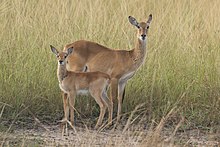| Kob | |
|---|---|

| |
| Male At the Queen Elizabeth National Park | |

| |
| Female and calf At the Semliki Wildlife Reserve both K. k. thomasi in Uganda | |
| Scientific classification | |
| Domain: | Eukaryota |
| Kingdom: | Animalia |
| Phylum: | Chordata |
| Class: | Mammalia |
| Order: | Artiodactyla |
| Family: | Bovidae |
| Genus: | Kobus |
| Species: | K. kob
|
| Binomial name | |
| Kobus kob (Erxleben, 1777)
| |
| Subspecies | |

| |
| Geographic range | |
The kob (Kobus kob) is an antelope found across Central Africa and parts of West Africa and East Africa. Together with the closely related reedbucks, waterbucks, lechwe, Nile lechwe, and puku, it forms the Reduncinae tribe.[2] Found along the northern savanna, it is often seen in Murchison Falls and Queen Elizabeth National Park, Uganda; Garamba and Virunga National Park, and the Democratic Republic of the Congo, as well as grassy floodplains of South Sudan.[3] Kob are found in wet areas (such as floodplains), where they eat grasses. Kob are diurnal, but inactive during the heat of the day. They live in groups of either females and calves or just males. These groups generally range from five to 40 animals.
Among the kobs of eastern Africa, the Ugandan kob (Kobus kob thomasi) appears on the coat of arms of Uganda,[4] and white-eared kobs (Kobus kob leucotis), found in South Sudan, southwest Ethiopia, and extreme northeast Uganda, participate in large-scale migrations.
- ^ IUCN SSC Antelope Specialist Group (2016). "Kobus kob". IUCN Red List of Threatened Species. 2016: e.T11036A50189609. Retrieved 3 June 2021.
- ^ Estes 1991, p. 91.
- ^ "Kob Antelope: Kobus Kob". ThinkQuest library. Archived from the original on 2007-08-07. Retrieved 2007-06-16.
- ^ "The Coat of Arms", High Commission of Uganda in Pretoria, retrieved 17 December 2018
